CITY LIFE AND
COUNTRY LIFE

Overview
In
this unit, you will read a story about two mice. One lives in the country, and the other lives
in the city. See what happens when they
visit each other. Like the mice in the
story, we live in the country, in the city or somewhere in between. Let’s take a look at how the land is used in
each of these places.
|
Message
to Adult Mentor |
|
This unit stresses the differences
among rural, urban and suburban environments.
In your discussions with the students, stress that each environment
uses the land in different ways. |
Where
Do You Live?
Do
you live in the country, in the city or somewhere in between? No matter where your home is, sometimes you
might wish you lived somewhere else.
That is the case with Marcie and Katie, two mice who want to try something
different. Read about their adventures
in the story below.
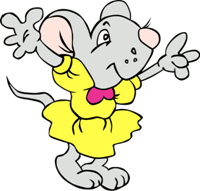
The Country Mouse and the City Mouse
A
little mouse named Katie lived in the country next to a field of corn. She lived in a small cottage where she felt
comfortable and safe. Her life was very
quiet and peaceful. One day her cousin,
Marcie, came from the city for a visit.
She wore a beautiful hat and carried a large suitcase. The two mice were happy to see each other and
said hello.
The city mouse thought this would
be a very nice place to take a vacation.
“I love this fresh, country air,” she said. Just then a tractor with big tires came
by. Then, a cow mooed loudly in her
ear. This scared the little mouse from
the city!
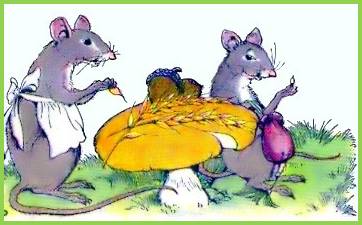
Katie led Marcie to her home just
in time for supper. She placed big bowls
of nuts, berries and grains on the table.
These were Katie’s favorite things to eat. She thought her cousin would enjoy the things
she picked from the garden outside her door, but Marcie thought the food was
too plain. “Come and stay with me in the
city. Life is much more interesting
there,” the city mouse said.
The very next day Marcie and
Katie hopped into a truck going to the city.
Katie could not believe how busy everything seemed. She was surprised to see that there were so
many cars and so many people! The little
country mouse was afraid of being crushed when a large, noisy bus rumbled by. Finally, they arrived at the house where
Marcie lived.
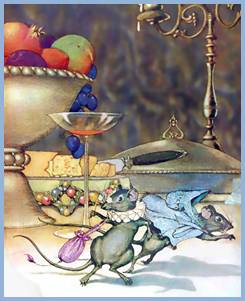
The house was also the home of a
large family. Katie was shocked to see a
big cat sleeping near the fireplace. The
two little mice were hungry after their long trip and were helping themselves
to a piece of cheese in the kitchen when the cook saw them. The cook screamed and woke the cat. The cat bounded across the floor, and the
mice scooted into a mouse hole to escape his sharp claws. Katie was really frightened now!
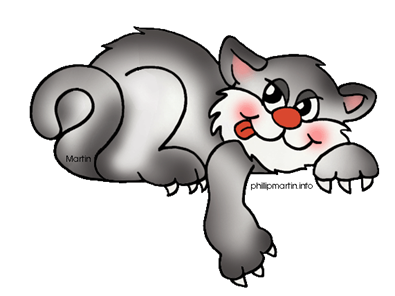
Katie and Marcie stayed up very
late and talked far into the night. The
country mouse realized that she was happy in the country; the city mouse
realized that she was happy in the city.
Katie was so glad to get back to her country cottage, and Marcie was
content to stay in the city in spite of the cat!
(Adapted from Aesop’s Fables)
![]() Go to Questions
1 through 4.
Go to Questions
1 through 4.
Different
Ways to Use the Land
Just
like Marcie and Katie in the story, we choose different places to live. Some of us like country life with its fields
and farms. Others enjoy living in the
city where there are busy streets and tall buildings. Some of us prefer being part of smaller communities. Almost all the neighborhoods we call home can
be described by one of the following words:
rural, urban or suburban. In each of these settings, people use the
land in different ways. Let’s explore
each one!

![]() Go to Question
5.
Go to Question
5.
Rural
Life
About
one-third of the world’s population lives in the countryside. There are no big cities, but there are small
towns and villages. This is known as a rural environment. Most of the land is taken up with farms and
fields. People use the land to grow crops
and to raise animals like cows, horses and pigs. There are also forests, mountains and lakes. The land is also used for hunting, fishing,
camping and hiking. The countryside is
usually cleaner and quieter than the city.
You can even have large animals like horses for pets.

Sometimes those who live in the
country may live long distances from the nearest town. In some places, there are few roads and
schools. Today, the Internet helps to
keep everyone connected. Farmers have
access to the latest information concerning their cattle or their crops. Notice in the picture below the farmer is
using a laptop in middle of a wheat field!
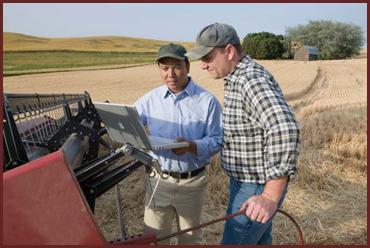
Children who live long distances
from schools are able to keep in touch with their teachers and to complete
their school work online. You can also
observe cell phone towers throughout the countryside. It can be hard to find jobs in rural areas,
and many young people leave to look for work in the cities. To learn more about rural communities, click
on the icon below.
![]() Go the Questions
6 and 7.
Go the Questions
6 and 7.
Urban Life
An
even larger part of the world’s population lives in cities or urban environments. Many people come into the city during the day
to work. Here the physical environment
has been changed to construct large buildings and roadways. This leaves little room for plants, trees and
lawns. Parks and green spaces give
people places to exercise and to play.
Little dogs, cats and birds that are happy in small spaces are popular
pets.
Cities are busy, noisy and
crowded areas where the land is used for stores, offices, hotels, restaurants,
museums and theaters. These are often
located in very tall buildings called skyscrapers. Professional sports teams play in large
stadiums and baseball parks. The streets
are packed with cars, trucks, taxis and buses.
All this traffic often makes the air dirty and breathing difficult. In some urban areas around the world, people
use bicycles to get to work. This makes
the air cleaner and healthier.
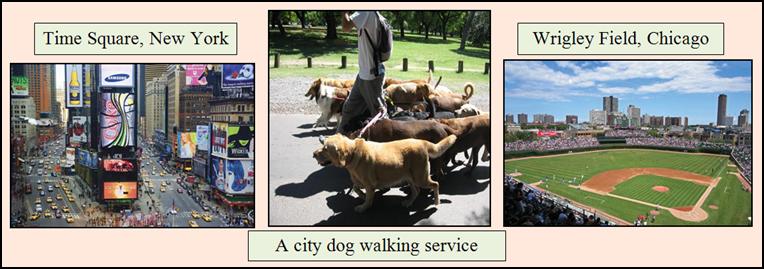
The sidewalks are busy both above
and below the ground. Underneath the
city, there are miles of cables that bring electricity, telephones and
television to the buildings. There are
also underground road and rail tunnels called subways. Pipes in the ground
below the city are used to carry gas and water.
If you click on the icon below, you can learn more about life in the
city.
![]() Go to Questions
7 through 9.
Go to Questions
7 through 9.
Suburban
Life
As
you can see, rural environments and urban environments are very different. Is there somewhere to live that is in between
the country and the city? Yes! It is known as the suburban environment or the suburbs. Suburban areas are less crowded than cities
but have more people than the countryside.
When people choose to live here, they may have to travel a distance to
get to work.

There are some businesses and
offices, but most of the land is used for homes, churches, and schools. It is also used for good roads so people can
go to jobs in the city easily. Houses
are built with yards surrounding them so the lawns can be used for gardens and
playgrounds. Parks, baseball fields and
community swimming pools give everyone places to play and to enjoy time with
friends. There is also enough space to
share with pets like dogs and cats. To
discover more about life in suburban areas, click on the icon below.
![]() Go to Questions
10 and 11.
Go to Questions
10 and 11.
Let’s
Review
Do
you remember the three types of environments you read about in this unit and
how the land is used in each of them?
·
Urban
environments: urban environments have cities that use the
land for offices, apartment buildings, businesses and large sports stadiums. There are large numbers of people and cars on
the busy streets.
·
Suburban
environments: suburban environments use the land for family
homes, schools and churches. There are
also parks and places to play. There are
fewer people here than in the city.
·
Rural
environments: rural environments use the land for farming
and for raising livestock. It is less
crowded here, and there is space for hunting, fishing and camping.
![]() Go to Questions
12 through 18.
Go to Questions
12 through 18.
Katie and
Marcie, the two mice in the story, learned that there were things they liked
and things they did not like about where they lived. Do you feel the same way?